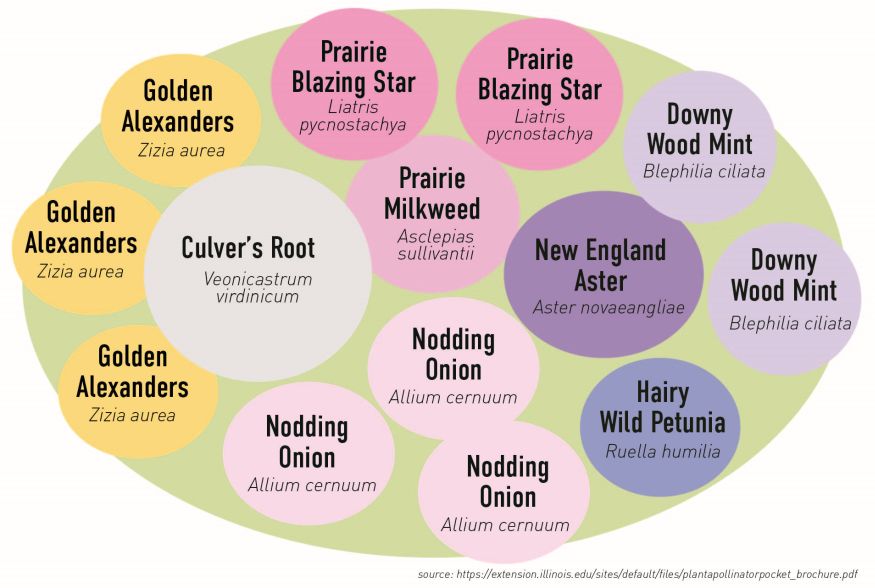Pollinator Pocket Initiative at Augustana
Purpose
The Pollinator Pocket Initiative is one way Augustana shows responsibility and care for the community and the planet as a whole, while serving its mission as an educational institution in a prairie state.
Pollinator pockets effectively support local and native pollinators by creating a refuge for insects. These gardens with native plantings are hardy, easy to maintain and aesthetically pleasing. They require less upkeep than a traditional lawn and often deter weeds from growing. They can be as small as a few planters with annual pollinators or as large as a field of prairie flowers.
Pollinator populations are essential to keeping ecosystems intact. The decline in insect pollinators has a cascade effect that changes plant communities, affects herbivores and carnivores, and disrupts the natural cycle essential to our food supply.
Augustana's pollinator pockets
Augustana’s pollinator pockets are heavily focused on native pollinator/general prairie seeds that do well within our climate zone and can flourish in our planting sites, which are partially sunny and moist. As recommended by Dr. Jason Koontz, professor of biology, the college works with Prairie Moon Nursery, which specializes in native prairie seed mixtures.
The pollinator pocket by Augustana’s Bell Tower was over-seeded with durable key plant species to ensure complete and long-lasting coverage. For the quarter-acre area, the following was used:
- ⅛ acre Grand Diversity seed mix: This mix contains Golden Alexanders (Zizia aurea), Wild Bergamot (Monarda fistulosa), Purple Coneflower (Echinacea purpurea) and Yellow Coneflower (Ratibida pinnata), which are particularly attractive to pollinator insects and also present a beautiful floral display. Rose/Swamp Milkweed (Asclepias incarnata) feeds caterpillars and adults of the monarch butterfly species. Foxglove Beardtongue (Penstemon digitalis) with an early bloom and Rattlesnake Master (Eryngium yuccifolium) with a long-lasting bloom also are included in this mix.
- ½ acre PDQ “Pretty Darn Quick” mix: While this mix includes many of the seeds of the Grand Diversity mix, is also includes Canada Milk Vetch (Astragalus canadensis), a great nectar source for bumblebees and honeybees, and Partridge Pea (Chamaecrista fasciculata), which does not only feed bees and other pollinators, but also supplies beneficial bacteria that help improve the soil.
How to build your own pollinator pocket
Pollinator pockets can be any size. Here are a few tips to help you create your own:
Step 1: Know what you’re working with
Find a location for your pollinator pocket and assess the soil type and levels of sunlight. The University of Illinois Extension offers guidance on suitable plants for different soil types, garden sizes and layouts.

This USDA map shows hardiness zones in Illinois. For a larger image, click here. To find information for different U.S. regions, click here.
Step 2: Find the right plants for you
Use native plants suited for your climate. Provide variety because insects tend to feed and use different plants for each life cycle. Be inspired with this list from the Illinois-Indiana Sea Grant, or this guide for different regions (including the Midwest) from the Xerces Society that also includes bloom periods.
Temperatures determine your planting zone. Knowing your zone will help you find plants that can tolerate the climate. The Quad Cities is in planting zone 5b. The USDA map shown here includes all zones.
Step 3: Prepare your garden
Clear the soil of grasses and any plant cover. Lawn grass tends to be dominant and must be uprooted and removed. Loosen the soil to allow seeds to germinate.
Step 4: Plan your garden layout
Choose a variety of flowers that bloom throughout the season and support all life cycles of the insects you hope to attract. Plan for one plant per square foot; this will help lock in moisture and discourage weeds. It also makes it easier for pollinators to travel from flower to flower.
Tip: Vary color and bloom time to add aesthetic value that lasts throughout spring and summer. Sow taller plants toward the center so they are easier to reach.
The University of Illinois Extension provides this 4x6-foot oval arrangement for moist to wet soil and full to partial sun as an example:

You can find more examples here.
Step 5: Plant
If you are planting seeds: Seeds need time to germinate and ideally should be planted in fall or late winter. If you are planting in the fall, disperse the seeds and cover them with soil. If you start your pollinator pocket in late winter, simply scatter the seeds over the snow. Eventually they will heat up and become anchored in the snow. The moisture of melting snow will help germinate the seeds.
If you are planting small plants: Follow the frost guidance and planting instructions included with the plant. Make holes large enough to fit the plant’s root system. Cover with soil. Adding mulch or rocks on top can help reduce weeds.
Step 6: Water, weed, wait
Water and weed your garden periodically. If you are planting milkweed, keep in mind that it can take a couple of seasons for milkweed to take root and flower.
